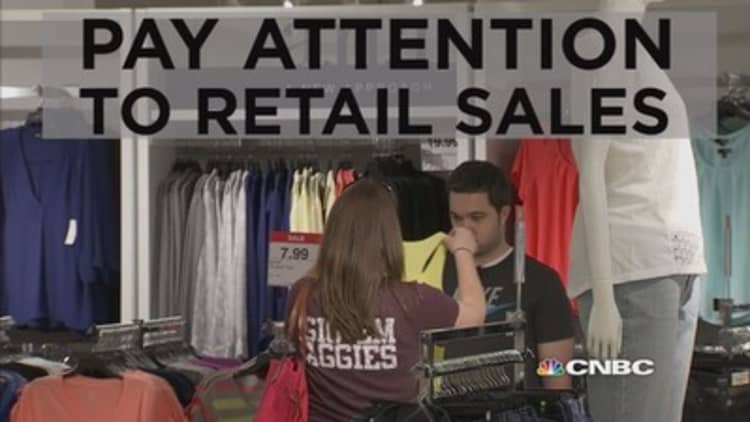
Major bank earnings and March's retail sales data could set the course for markets Tuesday.
Retail sales are expected to gain 1.1 percent, after February's decline of 0.6 percent.
"It's the first major report after the jobs number. It's expected to be fairly strong," said Win Thin, senior currency strategist at Brown Brothers Harriman. March's weak jobs report, with just 126,000 nonfarm payrolls, was a disappointment and prompted speculation that the Fed would now move slower to raise interest rates because of economic weakness.
The dollar slumped as a result, but it has since regained ground as traders focused on Fed comments and on other reports that were more positive. Retail sales, reported at 8:30 a.m. ET, could be an important indicator of whether the spring will see a rebound as many economists expect. There is also PPI producer inflation data at 8:30 a.m. and business inventories at 10 a.m. The NFIB small-business survey is released at 7:30 a.m. ET.
New York Fed President William Dudley speaks at 8:40 a.m., and Minneapolis Fed President Narayana Kocherlakota speaks at 8 p.m.
Read MoreInstead of audit, maybe the Fed needs stress test
"The dollar was picking up steam last week. I think the market is even looking beyond this noisy data. The euro
tested those recent lows, but it couldn't get through," said Thin, adding he's now watching the 104.60 level. "I suspect we'll need a good number to push through it, but a bad number doesn't mean a dollar sell off. The euro seems very heavy."
The dollar index rose close to 100 Monday, but stocks wobbled, in part on concerns about the upcoming rush of corporate earnings news. Stocks were mostly lower, with the Dow down 80 at 17,977, and the S&P 500 off 9 at 2092. Declines were led by industrials and utilities, both off more than 1 percent, and financials were the only major sector to gain, up 0.3 percent.
Read MoreOPEC slams oil producers with 'go-it-alone' attitudes
Traders are keeping a close eye on early morning reports from J.P. Morgan Chase and Wells Fargo, as well as Johnson & Johnson for what the health-care giant might say about the dollar's impact on foreign sales. While overall S&P 500 earnings are expected to be down by 2.9 percent, the profits of financial companies are expected to be 10.8 percent higher, according to Thomson Reuters.
J.P. Morgan earnings per share are expected to be up 8 percent at $1.39, and revenues are expected at $24.4 billion, 2 percent better than last year. Wells Fargo is expected to earn 98 cents, a decline of 7 percent, on revenues of $21.2 billion, a gain of 3 percent.
"We're not deep enough into the season to know whether there's something to be scared of or not," said Mark Luschini, chief market strategist at Janney Montgomery.
But Norfolk Southern, after the closing bell, reinforced some of the nervousness about earnings. The rail company said its earnings would be 15 percent lower than last year, and it blamed lower fuel surcharge revenue and lower coal volumes.
Read MoreTrader buys crash protection ahead of earnings
Norfolk Southern fell 4.5 percent in late trading and helped drive rival CSX lower. CSX, off 2.5 percent, reports earnings Tuesday. Rails were already down more than 2 percent during the trading day. Intel also reports after Tuesday's closing bell.
Of the S&P 500 companies reporting earnings Tuesday, Bespoke says Johnson & Johnson has beaten on earnings per share the most often, and Intel, on average, trades lower on the first day after its report.
Earnings for the S&P 500 are expected to decline for the first time in six years.
"If they are negative but beat estimates, will that be treated as good news?" said Luschini. "The other thing that could be treated as good news is if investors look past the energy patch." Sharply lower oil prices have hit energy company earnings hard, and S&P profits would be positive by several percent if energy were not included.
Luschini said the dollar is a wild card, and while it could be a factor in the second quarter as well, it could be a bigger negative than expected in the first quarter.
"There's not an inconsequential possibility that earnings come in a little worse than expected," he said.


